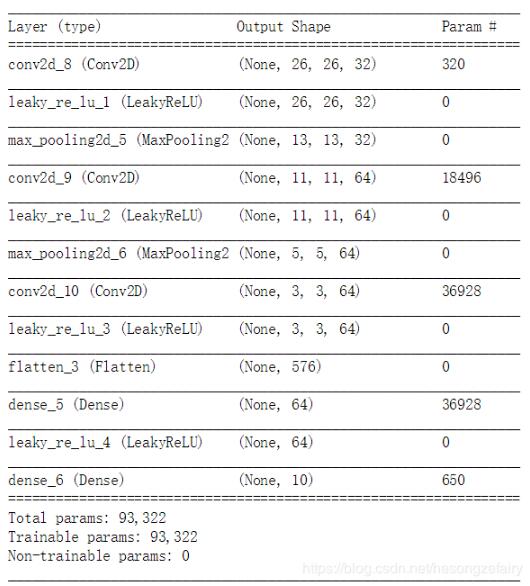在用Keras来实现CNN等一系列网络时,我们经常用ReLU作为激活函数,一般写法如下:
|
1
2
3
4
5
6
7
8
9
|
from keras import layersfrom keras import models model = models.Sequential()model.add(layers.Conv2D(32, (3, 3), activation='relu', input_shape=(28, 28, 1))) model.add(layers.MaxPooling2D((2, 2)))model.add(layers.Conv2D(64, (3, 3), activation='relu')) model.add(layers.MaxPooling2D((2, 2)))model.add(layers.Conv2D(64, (3, 3), activation='relu')) |
上面这段代码实现了一个基本的卷积神经网络,用ReLU作为激活函数,关于ReLU具体内容不做详细介绍。还有一些常用的主流激活函数:
softmax: 在多分类中常用的激活函数,是基于逻辑回归的。
Softplus:softplus(x)=log(1+e^x),近似生物神经激活函数,最近出现的。
Relu:近似生物神经激活函数,最近出现的。
tanh:双曲正切激活函数,也是很常用的。
sigmoid:S型曲线激活函数,最常用的。
hard_sigmoid:基于S型激活函数。
linear:线性激活函数,最简单的。
主流的激活函数可以如上述例子一样通过名称直接使用,但是还有一些复杂的激活函数如:Leaky ReLU、PReLU是不可以这样直接使用的,必须使用add方法将高级激活函数作为层(layer)来使用,举例如下:
|
1
2
3
4
5
6
7
8
9
10
11
12
13
14
15
|
from keras import layersfrom keras import modelsfrom keras.layers import LeakyReLU model = models.Sequential()model.add(layers.Conv2D(32, (3, 3), input_shape=(28, 28, 1)))model.add(LeakyReLU(alpha=0.05))model.add(layers.MaxPooling2D((2, 2))) model.add(layers.Conv2D(64, (3, 3))) model.add(LeakyReLU(alpha=0.05))model.add(layers.MaxPooling2D((2, 2))) model.add(layers.Conv2D(64, (3, 3))model.add(LeakyReLU(alpha=0.05)) |
这里我们在卷积层中去掉激活函数的参数,并在卷积层后加入高级激活层,下面来测试:
>>model.summary()

这里从整个网络结构的结果可以看出,卷积层后确实加入了一层新的激活层,使用的是LeakyReLU函数。
补充知识:Keras 调用leaky_relu
Keras 中有leaky_relu的实现。leaky_relu被整合进了relu函数。
参考官方文档:
https://tensorflow.google.cn/api_docs/python/tf/keras/backend/relu?hl=en
| Arguments | |
|---|---|
| x | A tensor or variable. |
| alpha | A scalar, slope of negative section (default=0.). |
| max_value | float. Saturation threshold. |
| threshold | float. Threshold value for thresholded activation. |
alpha(超参数)值控制负数部分线性函数的梯度。当alpha = 0 ,是原始的relu函数。当alpha >0,即为leaky_relu。
查看源码,在Keras.backbend 中,也是调用tensorflow.python.ops库nn中的leaky_relu函数实现的:
|
1
2
3
4
5
6
7
8
9
10
11
12
13
14
15
16
17
18
19
20
21
22
23
24
25
26
27
28
29
30
31
32
33
34
35
36
37
38
39
40
41
42
43
44
45
46
|
def relu(x, alpha=0., max_value=None, threshold=0): """Rectified linear unit. With default values, it returns element-wise `max(x, 0)`. Otherwise, it follows: `f(x) = max_value` for `x >= max_value`, `f(x) = x` for `threshold <= x < max_value`, `f(x) = alpha * (x - threshold)` otherwise. Arguments: x: A tensor or variable. alpha: A scalar, slope of negative section (default=`0.`). max_value: float. Saturation threshold. threshold: float. Threshold value for thresholded activation. Returns: A tensor. """ if alpha != 0.: if max_value is None and threshold == 0: return nn.leaky_relu(x, alpha=alpha) ##在这里调用了leaky_relu if threshold != 0: negative_part = nn.relu(-x + threshold) else: negative_part = nn.relu(-x) clip_max = max_value is not None if threshold != 0: # computes x for x > threshold else 0 x = x * math_ops.cast(math_ops.greater(x, threshold), floatx()) elif max_value == 6: # if no threshold, then can use nn.relu6 native TF op for performance x = nn.relu6(x) clip_max = False else: x = nn.relu(x) if clip_max: max_value = _constant_to_tensor(max_value, x.dtype.base_dtype) zero = _constant_to_tensor(0, x.dtype.base_dtype) x = clip_ops.clip_by_value(x, zero, max_value) if alpha != 0.: alpha = _to_tensor(alpha, x.dtype.base_dtype) x -= alpha * negative_part return x |
以上这篇Keras 中Leaky ReLU等高级激活函数的用法就是小编分享给大家的全部内容了,希望能给大家一个参考,也希望大家多多支持服务器之家。
原文链接:https://blog.csdn.net/hesongzefairy/article/details/86707352










